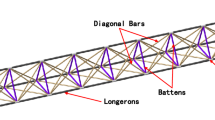Abstract
This study investigates the optimization of motion plans for the two dimensional variable geometry trusses (VGTs) in order to semi-actively reduce the vibration amplitude while the VGTs move a target payload from one point to another. We assume that the payload such as a trouble satellites have a control moment gyro or reaction wheel; corresponding sinusoidal disturbance is generated by the payload and it probably cause the resonance vibration of the VGTs during the manipulation. The natural frequency during the manipulation of the VGTs is given as a function of the geometry; hence, the motion plan for the VGTs can be optimized by considering difference between the frequency of the disturbance applied by the payload and the natural frequency of the VGTs. In order to study the effect of the geometry changes on the structural vibration during the manipulation, a numerical, two-dimensional VGT model that has three variable length members in the trusses is constructed by finite element method. The numerical results show that resonant vibration can occur for the specific trajectory of the VGT to move the target payload. We assumed that the VGT changes their geometry as quasi-static way. We optimize the trajectory and the three variable length members of the VGT in order to prevent the resonance by using a sequential quadratic programming. As a result, the optimized manipulation effectively reduces the amplitude of vibration. Furthermore, the stress of the truss members and the total number of the motion steps for the manipulation are evaluated.
























Similar content being viewed by others
References
Allaire G, Aubry S, Jouve F (2001) Eigenfrequency optimization in optimal design. Comput Methods Appl Mech Eng 190:3565–3579
Crawley EF (1994) Intelligent structures for aerospace: a technology overview and assessment. AIAA J 32(8):1689–1699
Fletcher R (1987) Practical methods of optimization. Wiley, Hoboken
Ghriblu H, Korayem MH (2006) Trajectory optimization of flexible mobile manipulators. Robotica 24:333–335
Gill PE, Murray W, Wright MH (1981) Practical optimization. Academic Press, London
Gill PE, Murray W, Wright MH (1991) Numerical linear algebra and optimization, vol 1. Addison Wesley, New York
Jensen JS, Pedersen NL (2006) On maximal eigenfrequency separation in two-material structures: the 1D and 2D scholar cases. J Sound Vib 289:967–986
Liu Z, Huang P, Yan J, Liu G (2009) Multi-objective genetic algorithms for trajectory optimization of space manipulator. In: Industrial electronics and applications, 2009. ICIEA 2009. 4th IEEE conference on, IEEE. (pp 2810–2815)
Ma ZD, Cheng HC, Kikuchi N (1994) Structural design for obtaining desired eigenfrequencies by using the topology and shape optimization method. Comput Syst Eng 5:77–89
Makihara K, Onoda J, Minesugi K (2006) New approach to semi-active vibration isolation to improve the pointing performance of observation satellites. Smart Mater Struct 15:342–350
Miura K, Furuya H, Suzuki K (1985) Variable geometry truss and its application to deployable truss and space crane arm. Acta Astronaut 12(7/8):599–607
Murotsu Y, Shao S (1991) The optimum adaptive geometries of intelligent truss structures for dynamic loading conditions (in Japanese). Trans JSME A 57(541):2140–2147
Olhoff N, Niu B, Cheng G (2012) Optimum design of band gap beam structures. Int J Solids Struct 49:3158–3169
Pedersen NL (2000) Maximization of eigenvalues using topology optimization. Struct Multidiscip Optim 20:2–11
Pedersen NL, Nielsen AK (2003) Optimization of practical trusses with constraints on eigenfrequencies, displacements, stresses, and buckling. Struct Multidiscip Optim 25:436–445
Pfeiffer F, Johanni R (1987) A concept for manipulator trajectory planning. IEEE J Robot Autom RA-3:115–123
Saramago SFP, Steffen V (1998) Optimization of the trajectory planning of robot manipulators taking into account the dynamics of the system. Mech Mach Theory 33:883–894
Senba A, Furuya H (2008) Implementation algorithms for self-identification of adaptive structures with variable geometric properties. Mech Syst Signal Process 22:1–14
Sigmund O, Jensen JS (2003) Systematic design of phononic band-gap materials and structures by topology optimization. Philos Trans R Soc Lond Ser A Math Phys Eng Sci 361:1001–1019
Utku S, Ramesh AV, Das SK, Wada BK, Chen GS (1991) Control of a slow-moving space crane as an adaptive structure. AIAA J 29(6):961–967
Yamazaki K, Sato I (1999) Optimum posture determination of variable geometry truss structures by optimality criteria method (in Japanese). Trans JSME C 65(640):4640–4646
Author information
Authors and Affiliations
Corresponding author
Appendix
Appendix
Appendix This study uses the SQP method to find the optimal set of three angles \(\alpha _{i}\) for \(i=1,2,3\). The SQP algorithms is briefly described here. Interested readers may consult with reference (Gill et al. 1981, 1991) for the details of the method.
The SQP method is known to be one of the reliable optimization method for constrained function of multi design variables. For the SQP problem, the search direction d for the design parameters \(\textbf {x}_{k}\) for kth iteration is found by using the quasi-Newton method. This direction finding process is usually called “QP subproblem” and is summarized as follows.
where f is an objective function, \(\nabla \) is a first order gradient, \(g_{i}\) is inequality constraints, and \(h_{j}\) is equality constraints. Thus, the SQP method uses second order information to obtain search direction vector.
Although the solution for (22)–(24) is obtained by using a penalty function approach, it is now considered relatively inefficient. Thus, (22)–(34) are then replaced by the Kunh–Tucker (KT) equations for the QP subproblem defined as follows.
The quasi-Newton method is then applied to find d for KT equations. For the quasi-Newton method, the approximation of Hessian matrix by a symmetric and positive definite matrix \(B_{k}\) is used. In each iteration, the matrix \(B_{k}\) should be updated for next iteration. Then, \(B_{k}\) in (22) is updated by the Broydon-Fletcher-Goldfarb-Shanno (BFGS) method (Fletcher 1987).
where L is a Lagrangian function, \(\lambda _{k}\) and \(\mu _{k}\) are Lagrange multipliers that contains constraints as follows.
Once the solution \(\textbf {d}_{k}\) is obtained, the next search point \(\textbf {x}_{k+1}\) of the design parameters is calculated as follows
where scalar \(\boldsymbol {\alpha }_{k}\) is obtained by solving a line search problem as follows.
Thus, the design parameters are sequentially updated by (37). The iteration of the design parameters is finished until the convergence criteria is satisfied.
Rights and permissions
About this article
Cite this article
Senba, A., Oka, K., Takahama, M. et al. Vibration reduction by natural frequency optimization for manipulation of a variable geometry truss. Struct Multidisc Optim 48, 939–954 (2013). https://doi.org/10.1007/s00158-013-0933-6
Received:
Revised:
Accepted:
Published:
Issue Date:
DOI: https://doi.org/10.1007/s00158-013-0933-6




